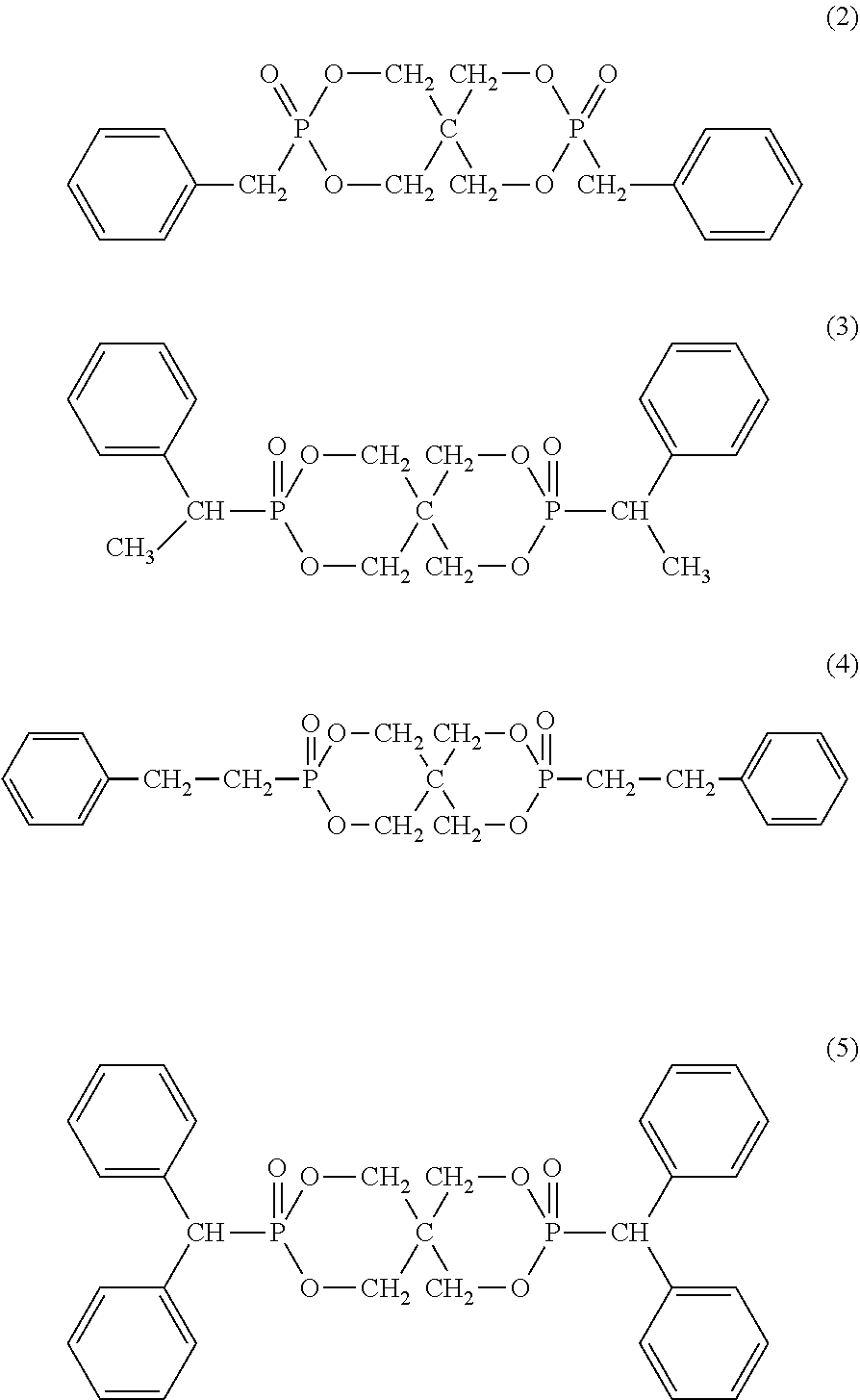Organic phosphorus-based compound, and flame retardant and flame-retardant product comprising the same
- Summary
- Abstract
- Description
- Claims
- Application Information
AI Technical Summary
Benefits of technology
Problems solved by technology
Method used
Image
Examples
example 1
Preparation of 2,4,8,10-tetraoxa-3,9-diphosphaspiro[5.5]undecane,3,9-dibenzyl-3,9-dioxide (Compound Represented by Formula (2), FR-1)
(Synthesizing Step)
[0104]22.55 g (0.055 mole) of 3,9-dibenzyloxy-2,4,8,10-tetraoxa-3,9-diphosphaspiro[5.5]undecane, 19.01 g (0.11 mole) of benzyl bromide and 33.54 g (0.32 mole) of xylene were fed to a reaction vessel having a stirrer, thermometer and capacitor, and dry nitrogen was caused to flow at room temperature under agitation. Then, the reaction product was heated with an oil bath at a reflux temperature (130 to 140° C.) for 4 hours and stirred.
(Cleaning Step 1)
[0105]After the end of heating, the resulting solution was left to be cooled to room temperature, and 20 mL of xylene was added and stirred for 30 minutes to precipitate a crystal. The precipitated crystal was separated by filtration and transferred into a beaker having a stirrer, and 20 mL of xylene was added to prepare slurry which was then stirred. Thereafter, the slurry was filtered a...
example 2
Preparation of 2,4,8,10-tetraoxa-3,9-diphosphaspiro[5.5]undecane,3,9-diα-methylbenzyl-3,9-dioxide (Compound Represented by Formula (3), FR-2)
(Synthesizing Step)
[0110]816.9 g (6.0 moles) of pentaerythritol, 19.0 g (0.24 mole) of pyridine and 2,250.4 g (24.4 moles) of toluene were fed to a reaction vessel having a thermometer, capacitor and dropping funnel and stirred. 1,651.8 g (12.0 moles) of phosphorus trichloride was added to the reaction vessel by using the dropping funnel and heated at 60° C. under agitation after addition. After the reaction, the obtained reaction product was cooled to room temperature, 5,180.7 g (61.0 moles) of methylene chloride was added to the reaction product, and 889.4 g (12.0 moles) of tertiary butanol and 150.2 g (1.77 moles) of methylene chloride were added dropwise under cooling with ice. The obtained crystal was cleaned with toluene and methylene chloride and filtered. The obtained product was dried at 80° C. and 1.33×102 Pa for 12 hours to obtain 1,...
example 3
Preparation of 2,4,8,10-tetraoxa-3,9-diphosphaspiro[5.5]undecane,3,9-di(2-phenylethyl)-3,9-dioxide (Compound Represented by Formula (4), FR-3)
(Synthesizing Step)
[0117]816.9 g (6.0 moles) of pentaerythritol, 19.0 g (0.24 mole) of pyridine and 2,250.4 g (24.4 moles) of toluene were fed to a reaction vessel having a thermometer, capacitor and dropping funnel and stirred. 1,651.8 g (12.0 moles) of phosphorus trichloride was added to the reaction vessel by using the dropping funnel and heated at 60° C. under agitation after addition. After the reaction, the obtained reaction product was cooled to room temperature, 5,180.7 g (61.0 moles) of methylene chloride was added to the obtained product, and 889.4 g (12.0 moles) of tertiary butanol and 150.2 g (1.77 moles) of methylene chloride were added dropwise under cooling with ice. The obtained crystal was cleaned with toluene and methylene chloride and filtered. The obtained product was dried at 80° C. and 1.33×102 Pa for 12 hours to obtain 1...
PUM
 Login to View More
Login to View More Abstract
Description
Claims
Application Information
 Login to View More
Login to View More - R&D
- Intellectual Property
- Life Sciences
- Materials
- Tech Scout
- Unparalleled Data Quality
- Higher Quality Content
- 60% Fewer Hallucinations
Browse by: Latest US Patents, China's latest patents, Technical Efficacy Thesaurus, Application Domain, Technology Topic, Popular Technical Reports.
© 2025 PatSnap. All rights reserved.Legal|Privacy policy|Modern Slavery Act Transparency Statement|Sitemap|About US| Contact US: help@patsnap.com



